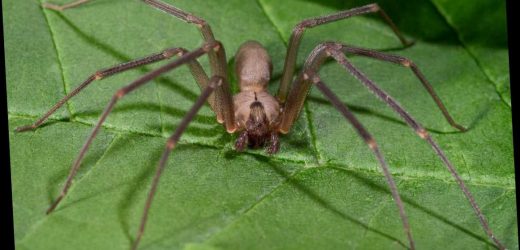A WAVE of poisonous brown recluse spiders has swept across the UK in recent years, with at least two children claiming to have been bitten.
Brown recluse spiders, which can leave those bitten sweating and feeling sick, are normally only found in the south and central United States.
What do brown recluse spiders look like?
Brown recluse spiders are normally between 6 and 20mm (0.2 and 0.8 inches) in length – but they can grow larger.
They are typically light to medium brown, and can vary in colour from whitish brown to blackish grey.
The spiders tend to have a violin shaped marking on the top side of their cephalothorax (fused head and thorax).
Because of this, the recluse is often nicknamed a fiddleback spider, brown fiddler, or violin spider.
However, cellar spiders and pirate spiders also have similar markings.
To tell the difference, it's best to examine the eyes.
Most spiders have eight, whereas recluse spiders have six – and an abdomen which is covered with short fine hairs, giving the appearance of soft fur.
Brown recluse spiders are the second most venomous spiders in the States, after black widows, and now they're feared to be invading British homes.
Where do brown spiders live?
Recluse spiders build asymmetrical webs – normally in dry, undisturbed places such as sheds, wardrobes, garages and cellars.
When inside a home, they like to dwell in cardboard boxes, shoes, chest of drawers, bed sheets of infrequently used beds, piles of clothes, work gloves, behind pictures, and inside toilets.
How long do brown recluse spiders live for?
Their life-cycle is about two to three years and each female produces several egg sacs between May and July.
There are around 50 eggs in each sac, and they take a month to hatch and a year to become adult.
The recluse spider is extremely resilient, and can live for six months in extreme drought and scarcity of food.
What are the signs of a brown recluse spider bite?
This spider's bite is often not felt immediately, but can still be serious.
Lesions tend to be red, white and blue patches – which can develop into a volcano lesion.
Symptoms of a bite
- Itching
- Chills
- Fever
- Nausea
- Sweating
- Feeling of discomfort
In severe cases, the bite will become gangrenous and can leave an open wound as large as a human hand.
It can take eight weeks or longer for a full recovery, and scars can be left as a result.
How do you treat a brown recluse spider bite?
NHS England advise anyone with a bite to seek medical advice by contacting their GP or calling NHS 111 if they experience the following:
- A large area (around 10cm or more) around the bite becomes red and swollen – your GP may refer you to an allergy clinic for further tests or treatment
- You have symptoms of a wound infection, such as pus or increasing pain, swelling or redness – you may need antibiotics
- You have symptoms of a more widespread infection, such as a fever, swollen glands and other flu-like symptoms
- You’re worried about a bite or sting
- Your symptoms don’t start to improve within a few days or are getting worse
- You’ve been stung or bitten in your mouth or throat, or near your eyes.
Source: Read Full Article





